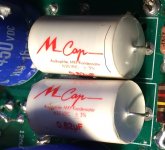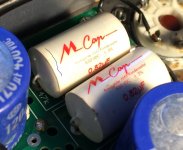Howdy All!
The left channel in my tube amp (Music Angel XD-800Mkiii) has recently developed noticeably lower output (compared to the right one).
I opened it up and noticed that the ends of one of the caps (M-Cap 0.82uF) is now convex (i.e. pushed out). The ends are normally concave (see adjacent cap beside the marked convex cap).
Is this indicative of a blown cap? Everything else looks good on the board.
Thanks!
The left channel in my tube amp (Music Angel XD-800Mkiii) has recently developed noticeably lower output (compared to the right one).
I opened it up and noticed that the ends of one of the caps (M-Cap 0.82uF) is now convex (i.e. pushed out). The ends are normally concave (see adjacent cap beside the marked convex cap).
Is this indicative of a blown cap? Everything else looks good on the board.
Thanks!
Attachments
Hi Norman,
I'm not familiar with those capacitors, but the convex ends don't look like a problem. I would expect to see cracks and possible venting if the ends were pushed out. For the following advice, you must turn off, discharge and unplug your amplifier. Do not fail to perform this step as the voltages inside this amplifier can kill you.
The normal failure mode for foil / film capacitors is for the conductors to burn away bit by bit if there is enough energy in the circuit. Not expected for grid coupling capacitors. There are two ways to check for this. One is to connect another like capacitor in parallel with the suspect cap. Then turn it on and see if the problem is corrected or not. The other (much better) way is to disconnect one end of the capacitor and test it with a good capacitance meter. Those functions on digital voltmeters can pass defective capacitors because you'll want to check leakage and dissipation factor.
Time for a good technician to look at your amplifier.
-Chris
I'm not familiar with those capacitors, but the convex ends don't look like a problem. I would expect to see cracks and possible venting if the ends were pushed out. For the following advice, you must turn off, discharge and unplug your amplifier. Do not fail to perform this step as the voltages inside this amplifier can kill you.
The normal failure mode for foil / film capacitors is for the conductors to burn away bit by bit if there is enough energy in the circuit. Not expected for grid coupling capacitors. There are two ways to check for this. One is to connect another like capacitor in parallel with the suspect cap. Then turn it on and see if the problem is corrected or not. The other (much better) way is to disconnect one end of the capacitor and test it with a good capacitance meter. Those functions on digital voltmeters can pass defective capacitors because you'll want to check leakage and dissipation factor.
Time for a good technician to look at your amplifier.
-Chris
Hi Norman,
I'm not up on who is still in business these days. The only good shop I know of is in this area. In Brampton, Ontario Audio is a good bet. They are backed up - as any good tech will be. I am swamped as well.
-Chris
I'm not up on who is still in business these days. The only good shop I know of is in this area. In Brampton, Ontario Audio is a good bet. They are backed up - as any good tech will be. I am swamped as well.
-Chris
In enlarged pictures some solder joints and oxidation on the capacitor leads look suspicious.
There are also some slight scorch marks on the circumference the capacitor ends (second picture).
One wonders how hot the internals of this equipment might be. You could measure resistances between points connected by the solder joints to see if you have continuity between.
There are also some slight scorch marks on the circumference the capacitor ends (second picture).
One wonders how hot the internals of this equipment might be. You could measure resistances between points connected by the solder joints to see if you have continuity between.
The shape is normal for those caps, its usually only at one end, which is also usually the outer foil end.
I would be more suspicious of the solder joint on those caps, to me it looks like a dry joint due to lack of solder.
I would be more suspicious of the solder joint on those caps, to me it looks like a dry joint due to lack of solder.
Problem solved.
The bias on the left channel was way off. Adjusted it and now all is good. Should have checked that I ruled out a bad tube.
The bias on the left channel was way off. Adjusted it and now all is good. Should have checked that I ruled out a bad tube.
If the solder joints are not as they should be you would not be getting the best performance from the equipment.
One wonders about this because of the oxidation of the capacitor leads which could be more due to conducted heat from some nearby resistance such as a bad solder joint rather than radiated from a valve or ballast resistor.
If the signs of deterioration are there a little preventive maintenance would be opportune as the presence of heat will make things progressively worse.
One wonders about this because of the oxidation of the capacitor leads which could be more due to conducted heat from some nearby resistance such as a bad solder joint rather than radiated from a valve or ballast resistor.
If the signs of deterioration are there a little preventive maintenance would be opportune as the presence of heat will make things progressively worse.
Last edited:
- Status
- Not open for further replies.
- Home
- Amplifiers
- Tubes / Valves
- Bad capacitor?

